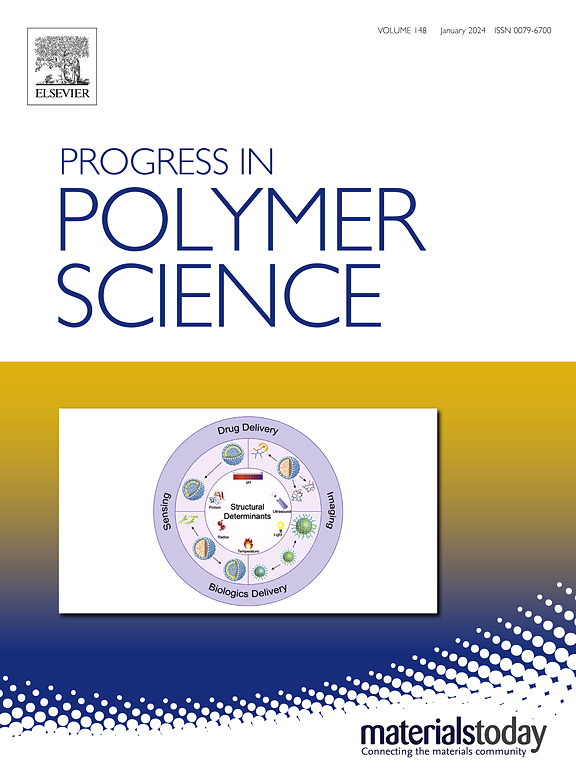梅奥·刘易斯方程的80年历史。典型和新兴共聚反应性比值数值估计技术综述
IF 26.1
1区 化学
Q1 POLYMER SCIENCE
引用次数: 0
摘要
微观结构和共聚物组成是由自由基共聚(FRCoP)和其他聚合化学合成的商品和定制材料的重要特征。1954年发表的梅奥-刘易斯方程(MLE)通过两个参数(反应性比(RR))提供了共聚单体和共聚物组成之间的直接关系,彻底改变了共聚实践和理论。从那时起,这个非线性方程的各种形式都基于共聚的终端模型(TM),通过拟合实验测量的共聚物组成作为共聚单体组成和/或单体转化率的函数来方便估计RR值。为允许线性回归方法而引入的早期转换已被强大的非线性数值方法所取代,这些方法提供了对反应性比率的统计有效估计。在这篇综述中,描述了线性和非线性数值方法的基本原理,重点介绍了在低转化率和中/高转化率下使用共聚物/单体组成数据确定RR的推荐非线性策略。综述了与RR值相关的联合置信区域(jcr)的形状和计算方法,并描述了确定RR值的实验优化设计。虽然非常稳健,但MLE不能对某些体系的共聚物组成提供充分的描述。对与派生相关的假设的检查为这些异常提供了上下文。概述了MLE的系统扩展,以捕获倒数第二单位效应、去传播和系统(例如溶剂、浓度、pH)依赖性的影响。此外,根据动力学基本原理分析了自由基共聚和可逆失活自由基共聚在共聚物组成上的差异。虽然偏离经典行为是例外而不是规则,但它们表明需要仔细研究任何新系统以验证MLE的适用性。本文章由计算机程序翻译,如有差异,请以英文原文为准。


80 years of the Mayo Lewis equation. A comprehensive review on the numerical estimation techniques for the reactivity ratios in typical and emerging copolymerizations
Microstructure and copolymer composition are characteristics important for both commodity and tailor-made materials synthesized by Free Radical Copolymerization (FRCoP) and other polymerization chemistries. The Mayo-Lewis equation (MLE), published in 1944, revolutionized copolymerization practice and theory by providing a straightforward relationship between comonomer and copolymer composition in terms of two parameters, the reactivity ratios (RR). Since that time, various forms of this non-linear equation, all based upon the terminal model (TM) of copolymerization, have been developed to facilitate estimation of RR values through fitting of experimentally measured copolymer compositions as a function of comonomer composition and/or monomer conversion. Early transformations introduced to allow linear regression methodologies have been replaced by powerful nonlinear numerical methods that provide statistically valid estimations of the reactivity ratios. In this review, the fundamentals of the linear and nonlinear numerical methodologies are described, with an emphasis on the recommended non-linear strategies for the determination of the RR using copolymer/monomer composition data at both low and moderate/high conversions. The shape and calculation of the Joint Confidence Regions (JCRs) associated with the RR values is also reviewed, and the optimal design of experiments for the determination of RR values is described.
While remarkably robust, the MLE does not provide an adequate description of copolymer composition for some systems. An examination of the assumptions associated with the derivation provides context for these exceptions. Systematic extensions of the MLE to capture the influence of penultimate unit effects, depropagation, and system (e.g., solvent, concentration, pH) dependencies are outlined. Additionally, discrepancies reported in the copolymer composition between the free-radical copolymerization and reversible deactivation radical copolymerization are analyzed in terms of kinetic fundamentals. While deviations from classic behavior are the exception rather than the rule, they demonstrate the need to carefully investigate any new system to validate the applicability of the MLE.
求助全文
通过发布文献求助,成功后即可免费获取论文全文。
去求助
来源期刊

Progress in Polymer Science
化学-高分子科学
CiteScore
48.70
自引率
1.10%
发文量
54
审稿时长
38 days
期刊介绍:
Progress in Polymer Science is a journal that publishes state-of-the-art overview articles in the field of polymer science and engineering. These articles are written by internationally recognized authorities in the discipline, making it a valuable resource for staying up-to-date with the latest developments in this rapidly growing field.
The journal serves as a link between original articles, innovations published in patents, and the most current knowledge of technology. It covers a wide range of topics within the traditional fields of polymer science, including chemistry, physics, and engineering involving polymers. Additionally, it explores interdisciplinary developing fields such as functional and specialty polymers, biomaterials, polymers in drug delivery, polymers in electronic applications, composites, conducting polymers, liquid crystalline materials, and the interphases between polymers and ceramics. The journal also highlights new fabrication techniques that are making significant contributions to the field.
The subject areas covered by Progress in Polymer Science include biomaterials, materials chemistry, organic chemistry, polymers and plastics, surfaces, coatings and films, and nanotechnology. The journal is indexed and abstracted in various databases, including Materials Science Citation Index, Chemical Abstracts, Engineering Index, Current Contents, FIZ Karlsruhe, Scopus, and INSPEC.
 求助内容:
求助内容: 应助结果提醒方式:
应助结果提醒方式:


